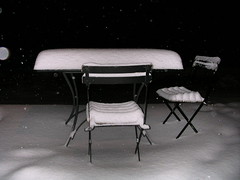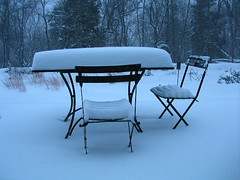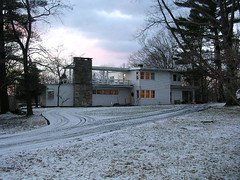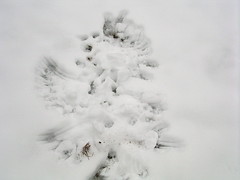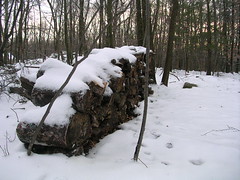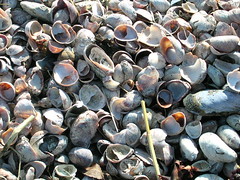I’ve been biased in favor of aggressively hunting deer in the suburbs for several years now. When I say “aggressively,” I mean something other than the aggression embodied by men wearing camouflage, smearing coal-black on their faces, and dousing themselves in bottled fox urine so they can trick unwary eight-point bucks into coming close enough to take an arrow in the heart.
I mean systematic hunts of does at a rate great enough to appreciably reduce the size of the herd.
My reasoning was sound but anecdotal. Since 1989, I’ve participated in Audubon’s summer bird count, in a territory that encompasses the upper parts of two of the Sound’s small tributaries. Over the years, the number of rufous-sided towhees, ovenbirds, grouse and other species that nest relatively close to the ground has dropped noticeably and unmistakably. Although the sample size was limited, the reason seemed obvious: deer had eaten away most of the understory that these birds need for nesting sites and cover.
Likewise, when I first moved to this area, more than 20 years ago, the woods in spring were a riot of wildflowers. Now, finding a trout lily or a wood anemone is a notable experience, and the fields of lady’s-tresses and patches of hepatica are gone.
I’d written about deer overpopulation when I was a reporter, but the last time was in 1999, and although I knew of one or two ongoing studies, I could never find anyone with any real authority who could attribute declines in nesting birds and wildflowers to deer.
But that was five years ago, and when I wasn’t paying attention, Audubon Greenwich did some work and wrote a report which, as I read it, had me nodding as only one who has had his biases confirmed can nod.
The report (it's here in PDF and here in a more usable form) says that before Europeans began colonizing what is now the United States, the best deer habitat supported eight to 11 deer per square mile. The fall from that peak was steep. In southern New England, market hunting and habitat loss (to farming) all but eliminated deer. By 1896 in Connecticut, there were an estimated 12 deer. But as abandoned farmland became forest, and suburbs became deer habitat, the number rose to 19,000 in 1974 and to 76,000 in 2000, or 15 per square mile, statewide.
In so-called back-country Greenwich, where Audubon Greenwich’s two sanctuaries are located, the habitat is much more luxurious and the deer are much more abundant. State officials took aerial photographs in 2002 and counted 43 to 60 deer per square mile. Experts believe that if you count deer in aerial photos, you miss as many as half the deer, so Audubon Greenwich estimates that the actual number per square mile is more like 90 to 120. For their half-mile-square sanctuary, that works out to 45 to 60 deer.
What’s the big deal? If there is such a thing as the balance of nature, it’s not in evidence at Audubon’s sanctuaries or, for that matter, in any of the nearby suburban areas that give the illusion of environmental health. If your purpose is to present nature in as varied a form as possible given the realities of soil, climate, etc., too many deer make it impossible.
Or if you simply want to enjoy nature in as varied a form as possible, deer make it impossible.
When I mentioned above that I found myself nodding in agreement as my biases were confirmed, these were the sections of the report I was referring to:
“Dramatic declines in species diversity of wildflowers have been observed. Canada mayflower, trout lily, lady slippers, and other species of orchids and lilies are much less common. Trilliums have been eliminated altogether. Common spring wildflowers that numbered tens, even hundreds of species in the 1950s can now be counted on two hands. The only species of wildflowers commonly seen today include Jack-in-the-pulpit, blue cohosh, wild leek, mayapple, garlic mustard, and dwarf ginseng.”
“Dramatic decline in the number of ground nesting/feeding birds during the 27-year period is apparent. Total number of species remained relatively unaffected, but the total number of territories showed a 28% decline due to simplification of the forest structure. In addition, mid-canopy nesters such as the wood thrush, scarlet tanager, and eastern wood pewee are starting to show a decline in numbers associated with the disappearance of the middle canopy layer.”
Left alone, a deer population will double in size in two to three years. And while a herd will inevitably spread out, deer are territorial -- does are faithful to the area in which they were born and will stay on their summer range for life.
Audubon reviewed its options and decided the only one feasible was to work with a group of local hunters to radically thin the herd. They began in late 2003 and are continuing this winter.
Tom Baptist, Audubon Greenwich’s executive director, e-mailed me a summary of the first year: 16 hunters spent 347.4 hours in the field and killed 30 deer – 28 females and two antler-less males.
In other words, based on Audubon’s own estimate of its sanctuaries’ deer population, the hunters killed at least half the deer on its property, and maybe more than half.
The goal is to get down to just five to seven deer, at which point, Audubon thinks, the deer and their habitat will be in balance.
What that means isn’t quite clear. The report suggests that tree seedlings will rebound dramatically within several years. As for wildflowers, “when browsing pressure lasts for a decade or longer, they are simply eliminated due to lack of seed source …. Relieving grazing pressure by the reduction of deer may not restore the wildflower community, in which case active restoration efforts will be necessary to re-establish the representative native wildflower species.”
The Audubon Center plans to keep track of revegetation, and to keep the deer herd at a sustainable level by periodic hunting.


